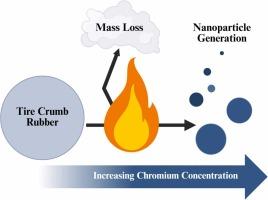野火诱导轮胎橡胶颗粒中铬纳米颗粒的释放
IF 11.3
1区 环境科学与生态学
Q1 ENGINEERING, ENVIRONMENTAL
引用次数: 0
摘要
野火活动在荒地-城市交界面越来越多地燃烧建筑物和人为材料。文献记载,野火改变了自然环境中微量金属的形态并增加了它们的流动性,但对于它们在燃烧的人为材料中的命运却知之甚少。我们使用单颗粒电感耦合等离子质谱(spICP-MS)来研究野火期间燃烧如何影响轮胎碎橡胶(TCR)中的元素组成和含金属纳米颗粒(<100 nm)的大小,TCR是运动场,花园和城市地区使用的废旧轮胎副产品。研究表明,操场上燃烧的TCR是含有纳米颗粒(NPs)的潜在有毒金属的来源,包括Cr、Ni、Zn、Pb和Cu。燃烧后的TCR中含金属的NPs明显多于未燃烧的NPs,表明其具有更大的环境流动性。我们报告了燃烧产生的独特富Cr NPs种群,这在其他金属中没有观察到。这些NPs显示每个粒子的Cr质量增加,数量增加了两个数量级以上。纳米颗粒是呼吸暴露于微量金属的载体,其小尺寸增加了对肺部的渗透,因此研究广泛用于建筑环境的人为材料的NP释放具有重要意义。本文章由计算机程序翻译,如有差异,请以英文原文为准。

Wildfire induced release of Cr nanoparticles from Tire Crumb Rubber
Wildfire activity at the Wildland-Urban Interface is increasingly burning structures and anthropogenic materials. It is documented that wildfire alters the form and increases mobility of trace metals in natural environments, yet little is known about their fate in burned anthropogenic materials. We use single particle inductively coupled plasma mass spectrometry (spICP-MS), to examine how burning during a wildfire impacted the elemental composition, and size of metal containing nanoparticles (<100 nm) in Tire Crumb Rubber (TCR), an end-of-life tire byproduct used in playgrounds, gardens, and urban areas. We show that burned TCR from a playground is a source of potentially toxic metal containing nanoparticles (NPs), including Cr, Ni, Zn, Pb, and Cu. Metal-containing NPs from burned TCR were significantly more abundant than unburned, suggesting greater environmental mobility. We report a unique population of Cr rich NPs resulting from burning, and which were not observed for other metals. These NPs showed increased Cr mass per particle and over two orders of magnitude increase in number. Nanoparticles are a vector for respiratory exposure to trace metals, with their small size increasing penetration into the lung, underpinning the importance of studying NP release from anthropogenic materials which are widely used in the built environment.
求助全文
通过发布文献求助,成功后即可免费获取论文全文。
去求助
来源期刊

Journal of Hazardous Materials
工程技术-工程:环境
CiteScore
25.40
自引率
5.90%
发文量
3059
审稿时长
58 days
期刊介绍:
The Journal of Hazardous Materials serves as a global platform for promoting cutting-edge research in the field of Environmental Science and Engineering. Our publication features a wide range of articles, including full-length research papers, review articles, and perspectives, with the aim of enhancing our understanding of the dangers and risks associated with various materials concerning public health and the environment. It is important to note that the term "environmental contaminants" refers specifically to substances that pose hazardous effects through contamination, while excluding those that do not have such impacts on the environment or human health. Moreover, we emphasize the distinction between wastes and hazardous materials in order to provide further clarity on the scope of the journal. We have a keen interest in exploring specific compounds and microbial agents that have adverse effects on the environment.
 求助内容:
求助内容: 应助结果提醒方式:
应助结果提醒方式:


